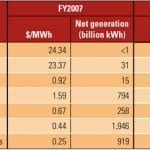The American Wind Energy Association (AWEA) estimates that 37,000 jobs will be lost should the federal production tax credit (PTC) not be renewed this year. The source of that estimate is a December 2011 Navigant Consulting study paid for by AWEA in which the consulting firm surveyed the 20 largest manufacturers of wind turbine blades, turbines, and towers. One of the six survey questions to manufacturers was to determine the percentage of the workforce lost if the PTC were not renewed.
That employment loss estimate was then extrapolated over Navigant and AWEA databases of U.S. wind manufacturing and indirect industry jobs and coupled with AWEA’s very optimistic estimates of future wind industry growth and of supply of domestic content to arrive at the 37,000 job loss figure in 2013 (see page 6 of the report). The Navigant report estimates that there were about 12,000 direct manufacturing jobs as of December 2011 and that loss of the PTC will result in perhaps 4,000 (one-third) direct manufacturing job losses in 2013.
I was surprised to learn that the highest job losses aren’t in manufacturing but in indirect or peripheral jobs, such as finance, logistics, consulting, engineering, and construction. Subtracting the manufacturing job loss estimates from the total estimate, we find that the indirect job losses are more than eight times the direct manufacturing job losses. AWEA is telling us that for every manufacturing job lost, there are eight other downstream or indirect job losses. This factor doesn’t pass the sanity test. The usual manufacturing indirect job loss factor is two or three, meaning that the loss of one manufacturing job results in the economic loss of two or three jobs. A factor of two, for example, is often used in the aerospace industry. I doubt the wind business is much different.
Other researchers when performing similar analyses have used the AWEA employment estimates, although the data has been inconsistent. In a report published on September 23, 2011, titled "U.S. Wind Turbine Manufacturing: Federal Support for an Emerging Industry," the Congressional Research Service references AWEA as the source of the number: “an estimated 20,000 U.S. workers were employed in the manufacturing of wind turbines in 2010”—clearly a reference to direct manufacturing jobs. No explanation is given for why reports prepared at exactly the same time using AWEA data have remarkably different direct manufacturing job estimates.
Job Losses at Coal Plants Mounting
In another sector of the power business, the American Coalition for Clean Coal Electricity (ACCCE) estimates the recent spate of regulations from the Environmental Protection Agency (EPA) has been “a factor in the announced retirement of almost 28 GW of coal-fired capacity in 22 states.” The ACCCE “conservatively estimates these coal plant retirement will cause a total net loss of 10-000 – 14,000 jobs.” These numbers include an indirect job loss multiplier of 2.4, which is in the ballpark of reasonable indirect job losses.
To be fair, the process used by ACCCE to estimate job losses due to coal plant retirements is also very arbitrary. ACCCE used actual job losses when the numbers were announced by utilities but applied a factor of 0.12 – 0.22 employees per MW to arrive at other plant job loss estimates. If plants were repowered with gas, then a lower gas employment factor was used to reflect job additions elsewhere in the company. So, if 50 GW of coal-fired plants ultimately retire, as many believe, the job losses could range from 17,000 to 25,000, including indirect jobs.
Coal Producers Also Losing Jobs
Coal producers are also affected by the reduction in coal-fired generation. "Our members count on coal-fired power plants and burning of coal to keep jobs,” Mike Caputo, a United Mine Workers of America (UMWA) official said. “We’re a very Democratic [sic] union and we try to listen to the rank and file. They’ve sent a clear message that they’re not supportive of the environmental rules that are being put in place.” In fact, the UMWA has decided not to endorse either presidential candidate. Caputo acknowledges that the low price of natural gas is partially at fault for the union job losses but notes that politically, the EPA is the culprit for the coal industry’s woes.
UMWA President Cecil Roberts made headlines earlier this year when he made a terrorism analogy to describe the actions of EPA Administrator Lisa Jackson and said that the agency’s rules prevent the UMWA from endorsing Obama. “The Navy SEALs shot Osama bin Laden in Pakistan and Lisa Jackson shot us in Washington,” Roberts said on a West Virginia radio show in April. Although recent UMWA membership numbers aren’t available, industry observers claim membership has seen a steep decline of late.
There is little doubt that low natural gas prices have had a major impact on coal mining and coal plant closures, and a good case can be made that natural gas is more to blame than the EPA. Many workers from coal-fired plants will transition to the gas-fired side of the power business. In the coal mining and production business, direct job losses are likely to be more permanent and may grow to be five to 10 times the direct job losses predicted by AWEA in the wind industry with loss of the PTC. These coal workers have little choice but to retrain for other jobs in another industry, if possible.
Ironically, low natural gas prices have had an equally pervasive impact on the wind industry. The PTC, now 2.2 cents/kWh, represents a significant percentage of the fuel price paid to fire natural gas plants these days and is thought to be too generous in some political circles. The PTC also allows wind turbine owners to bid negative prices into the power market, which has caused periodic system disruptions in different parts of the country. Exelon, a long-time AWEA board member and owner of about 2% of the nation’s wind capacity, was expelled from AWEA’s governing board in mid-September for being truthful about the adverse impact of wind power on its system.
Which Jobs Should Be Saved?
AWEA is doing exactly what is expected of a lobbyist organization—advocating for its constituents. I don’t fault AWEA for those actions. However, there are other segments of the power industry that are also undergoing fundamental, structural changes, and those changes are also causing heavy job losses, much larger than what AWEA estimates for the wind industry. Jobs lost in the wind industry are no more or less important than any of the thousands of jobs already lost in the coal or power industries.
AWEA is campaigning for PTC renewal in order to preserve constituent jobs. Preserving jobs was not part of the original legislative justification for the PTC and it’s not a suitable justification for extending the credit today.
The PTC, part of the Energy Policy Act of 1992, has been in effect for 18 years. Yes, the credit has expired on three occasions and has been extended five times, and that uncertainty has been disruptive. However, everyone entering or investing in the wind business knew up front that his or her job or investment was largely contingent on continuing government support of the PTC and that support has been uneven over the years. Each also knew upfront that someday the PTC would not be renewed.
The wind industry has reached the age of majority, and the time has come for it to leave home and make its own way in the often-cruel and always competitive marketplace, without further handouts from Uncle Sam.
—Dr. Robert Peltier, PE is COAL POWER’s editor-in-chief.








